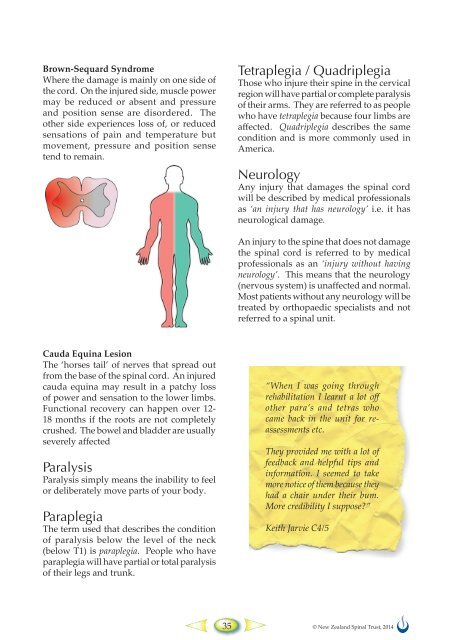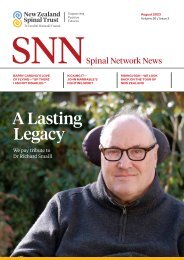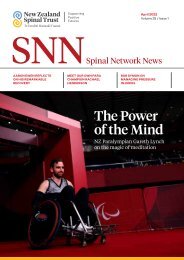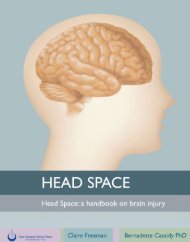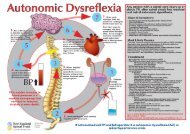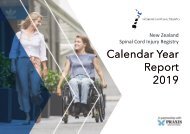Back_on_Track_Promo2016a
You also want an ePaper? Increase the reach of your titles
YUMPU automatically turns print PDFs into web optimized ePapers that Google loves.
Brown-Sequard Syndrome<br />
Where the damage is mainly <strong>on</strong> <strong>on</strong>e side of<br />
the cord. On the injured side, muscle power<br />
may be reduced or absent and pressure<br />
and positi<strong>on</strong> sense are disordered. The<br />
other side experiences loss of, or reduced<br />
sensati<strong>on</strong>s of pain and temperature but<br />
movement, pressure and positi<strong>on</strong> sense<br />
tend to remain.<br />
Tetraplegia / Quadriplegia<br />
Those who injure their spine in the cervical<br />
regi<strong>on</strong> will have partial or complete paralysis<br />
of their arms. They are referred to as people<br />
who have tetraplegia because four limbs are<br />
affected. Quadriplegia describes the same<br />
c<strong>on</strong>diti<strong>on</strong> and is more comm<strong>on</strong>ly used in<br />
America.<br />
Neurology<br />
Any injury that damages the spinal cord<br />
will be described by medical professi<strong>on</strong>als<br />
as ‘an injury that has neurology’ i.e. it has<br />
neurological damage.<br />
An injury to the spine that does not damage<br />
the spinal cord is referred to by medical<br />
professi<strong>on</strong>als as an ‘injury without having<br />
neurology’. This means that the neurology<br />
(nervous system) is unaffected and normal.<br />
Most patients without any neurology will be<br />
treated by orthopaedic specialists and not<br />
referred to a spinal unit.<br />
Cauda Equina Lesi<strong>on</strong><br />
The ‘horses tail’ of nerves that spread out<br />
from the base of the spinal cord. An injured<br />
cauda equina may result in a patchy loss<br />
of power and sensati<strong>on</strong> to the lower limbs.<br />
Functi<strong>on</strong>al recovery can happen over 12-<br />
18 m<strong>on</strong>ths if the roots are not completely<br />
crushed. The bowel and bladder are usually<br />
severely affected<br />
Paralysis<br />
Paralysis simply means the inability to feel<br />
or deliberately move parts of your body.<br />
Paraplegia<br />
The term used that describes the c<strong>on</strong>diti<strong>on</strong><br />
of paralysis below the level of the neck<br />
(below T1) is paraplegia. People who have<br />
paraplegia will have partial or total paralysis<br />
of their legs and trunk.<br />
“When I was going through<br />
rehabilitati<strong>on</strong> I learnt a lot off<br />
other para’s and tetras who<br />
came back in the unit for reassessments<br />
etc.<br />
They provided me with a lot of<br />
feedback and helpful tips and<br />
informati<strong>on</strong>. I seemed to take<br />
more notice of them because they<br />
had a chair under their bum.<br />
More credibility I suppose?”<br />
Keith Jarvie C4/5<br />
35<br />
© New Zealand Spinal Trust, 2014


